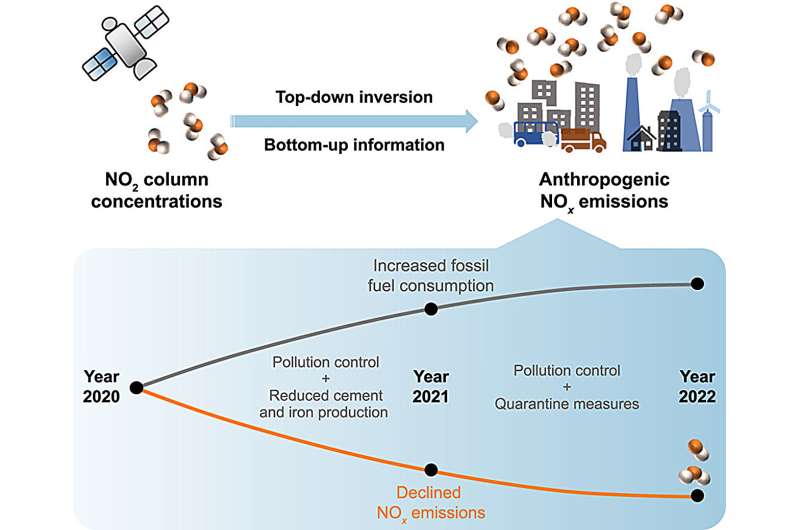
Study finds consistent decline in nitrogen oxides emissions from human activities in China since 2020 (Image Credit: Phys.org)

Nitrogen oxides (NOx) form aerosols and ozone in the atmosphere and are significant contributors to air pollution and climate change. China is the largest emitter, yet accurate and timely information on NOx emissions in China has been lacking since 2020 due to delays in emissions reporting.
In a study published in Environmental Science and Ecotechnology, researchers developed a satellite-based inversion system for real-time monitoring of regional air pollution emissions. Using data from this system and other independent observations, they show a consistent decline in China’s NOx emissions from 2020-2022, despite increased fossil fuel consumption.
A reduction in transportation-associated emissions, largely due to the COVID-19 lockdowns, slightly lowered China’s NOx emissions in 2020. In 2021 and 2022, reductions in NOx emissions were achieved within the industrial and transportation sectors through stringent air pollution controls. These controls appear to have accounted for more than 70% of the total reduction.
This reduction was corroborated by data from two independent spaceborne instruments—the TROPOspheric Monitoring Instrument (TROPOMI) and the Ozone Monitoring Instrument (OMI). TROPOMI is on board the European Copernicus Sentinel-5 Precursor (S5P), which launched in 2017 and is the most widely used satellite instrument monitoring NO2 pollution because it offers global daily NO2 tropospheric vertical column densities (TVCDs) sampled at 13:30 local time with a current resolution of up to 5.5 × 3.5 km.
OMI is on the National Aeronautics and Space Administration (NASA)’s EOS-Aura spacecraft, providing global daily NO2 TVCDs sampled at 13:40 local time with a resolution of 13 × 24 km.
Monthly total NOx emissions between 2020 and 2022 in China were inferred from satellite retrievals of NO2 TVCDs using the mass balance method, assuming a localized relation between the changes in NO2 TVCDs and NOx emissions.
Despite a decrease in NOx emissions, the research team did not observe a concurrent decline in China’s CO2 emissions due to the increased fossil fuel consumption, which suggests a difficulty in achieving coordinated governance of air quality and climate pollutants under the current energy structure.
The authors conclude that a satellite-based inversion system like the one presented in this study could be a crucial part of such a coordinated approach, enabling tracking of air pollutant emissions by sector with low latency.
More information:
Hui Li et al, Trends and drivers of anthropogenic NO emissions in China since 2020, Environmental Science and Ecotechnology (2024). DOI: 10.1016/j.ese.2024.100425
Provided by
Eurasia Academic Publishing Group
Study finds consistent decline in nitrogen oxides emissions from human activities in China since 2020 (2024, May 9)
retrieved 10 May 2024
from https://phys.org/news/2024-05-decline-nitrogen-oxides-emissions-human.html
part may be reproduced without the written permission. The content is provided for information purposes only.





